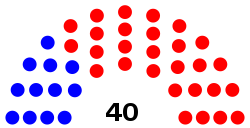History
For much of its history, Florida's legislature was limited to men and blacks were excluded. During the Reconstruction era after the American Civil War, Republicans held power in the state and nationally. The enfranchised African Americans who voted and helped elect officeholders at the local, state, and federal levels. After Reconstruction ended Democrats regained power, disenfranchised blacks, and excluded them from local and state offices until the civil rights era of the 1960s. Florida's 19th century state officeholders are noted at African American officeholders from the end of the Civil War until before 1900.
The 19th Amendment to the U.S. Constitution became law on August 26th, 1920 and enfranchised women voters even though Florida did no ratify the federal law for decades. Florida ratified the amendment in 1969. [4] Edna Giles Fuller began serving in the Florida House in 1929. Beth Johnson began serving in the Florida Senate 1963. [5]
Legislative session
Regular legislative sessions
The Florida Legislature meets in a 60-day regular legislative session each year. Regular legislative sessions in odd-numbered years must begin on the first Tuesday after the first Monday in March and on the second Tuesday after the first Monday in January of each even-numbered year. [8]
Before 1991, the regular legislative session began in April. Senate Joint Resolution 380 (1989) proposed to the voters a constitutional amendment (approved November 1990) that shifted the starting date of regular legislative session from April to February. Subsequently, Senate Joint Resolution 2606 (1994) proposed to the voters a constitutional amendment (approved November 1994) shifting the start date to March, where it remains. In recent years, the legislature has opted to start in January to allow lawmakers to be home with their families during school spring breaks, and to give more time ahead of the legislative elections in the Fall. [10]
Special legislative sessions
Special legislative sessions may be called by the governor, by a joint proclamation of the Senate president and House speaker, or by a three-fifths vote of all legislators. During any special session, the legislature may only address legislative business that is within the purview of the purpose or purposes stated in the special session proclamation. [11]
Powers and process
The Florida Legislature is authorized by the Florida Constitution to create and amend the laws of the state of Florida, subject to the governor's power to veto legislation. To do so, legislators propose legislation in the forms of bills drafted by a nonpartisan, professional staff. Successful legislation must undergo committee review, three readings on the floor of each house, with appropriate voting majorities, as required, and either be signed into law by the governor or enacted through a veto override approved by two-thirds of the membership of each legislative house. [12]
Its statutes, called "chapter laws" or generically as "slip laws" when printed separately, are compiled into the Laws of Florida and are called "session laws". [13] The Florida Statutes are the codified statutory laws of the state. [13]
In 2009, legislators filed 2,138 bills for consideration. On average, the legislature has passed about 300 bills into law annually. [14]
In 2013, the legislature filed about 2,000 bills. About 1,000 of these were "member bills." The remainder are bills by committees responsible for certain functions, such as the budget. In 2016, about 15% of the bills were passed. [15] In 2017, 1,885 lobbyists registered to represent 3,724 entities. [15]
The legislature also has the power to propose amendments to the Florida Constitution.
This page is based on this
Wikipedia article Text is available under the
CC BY-SA 4.0 license; additional terms may apply.
Images, videos and audio are available under their respective licenses.





